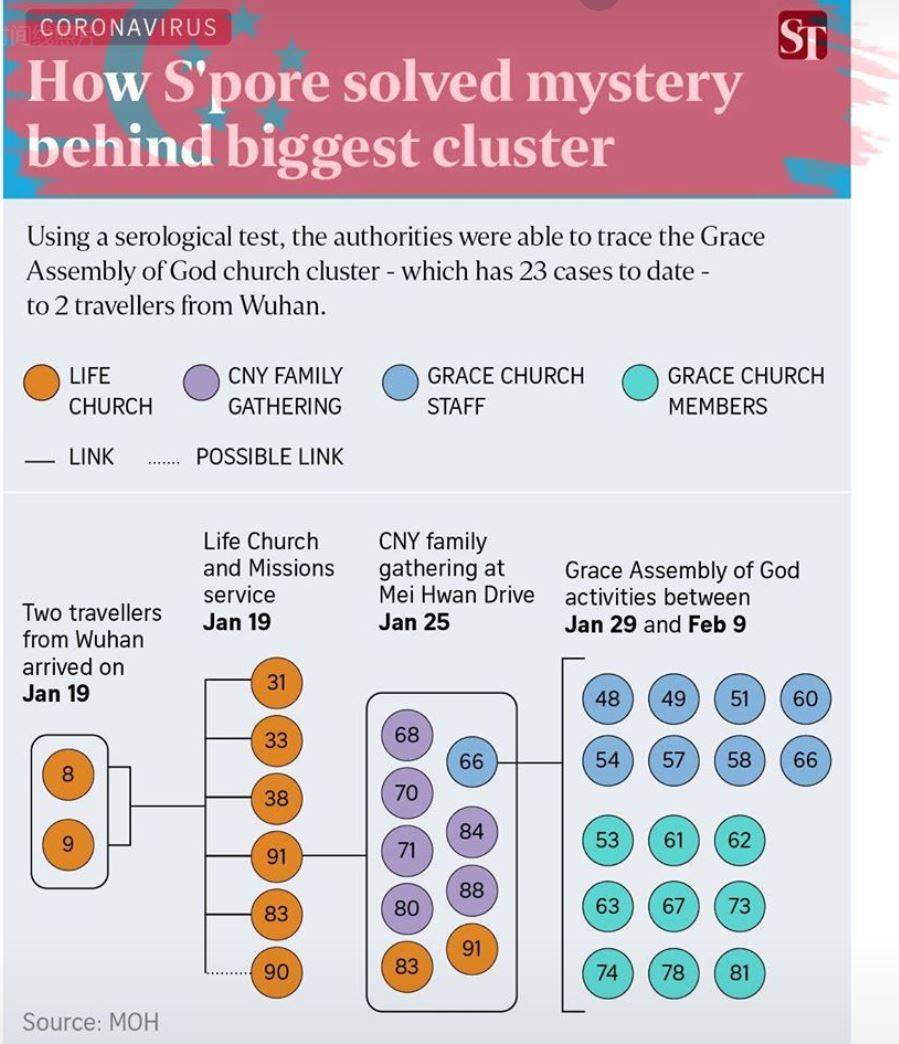|
|

楼主 |
发表于 26-2-2020 09:24 AM
|
显示全部楼层
本帖最后由 kcchiew 于 26-2-2020 09:30 AM 编辑
这个厉害, “确诊”了痊愈后的病例, case 83和 91.
moh.gov.sg/news-highlights/details/links-established-between-church-clusters-and-wuhan-travellers
这样应该可以查那些无法追溯源头的确诊病例吗? 检测花费贵吗?
Establishing the links between the church clusters and source of infection
4. To determine how Case 66 had been infected, we investigated the locations he had visited, and people he had close contact with. We found that Case 66 had attended a Chinese New Year gathering at Mei Hwan Drive on 25 January. Cases 83 and 91 had also attended the same gathering. Hence there is a possible link between the cluster at Grace Assembly of God and the Chinese New Year gathering at Mei Hwan Drive.
5. Cases 83 and 91 are a married couple, and they were both not sick (i.e. they had no symptoms) at the time of investigations. But MOH’s records showed that Case 91 had gone to the emergency department at Sengkang General Hospital earlier on 26 January with symptoms consistent with COVID-19. Case 83 had also been unwell in end-January, and had repeatedly sought treatment at a general practitioner clinic.
6. Based on this finding, the MOH epidemiology team arranged for Cases 83 and 91 to be tested at the National Centre for Infectious Diseases, including the use of serological tests developed by researchers from the Duke-NUS Medical School. Their test results confirmed that they had earlier been infected with COVID-19.
7. Our investigations had earlier uncovered that Cases 83 and 91 were at The Life Church and Missions Singapore on the same day as Cases 8 and 9 – the Chinese nationals from Wuhan who had visited the church on 19 January. This meant that Cases 83 and 91 likely got infected from Cases 8 and 9, and went on to pass the infection to Case 66 at the Chinese New Year gathering on 25 January. Case 66 subsequently passed the infection to his colleagues at Grace Assembly of God.
A world-first in serological testing
8. The laboratory test currently used to confirm COVID-19 infection is a molecular test called Polymerase Chain Reaction (PCR), which detects the presence of viral genetic material in a biological sample obtained from a patient. This test will not work if the patient has recovered and his body’s immune system has cleared the virus. However, the immune system produces antibodies in response to the infection. These virus specific antibodies will stay with the recovered patient for longer periods of time, which could be for at least several years.
9. The research team at Duke-NUS Medical School had earlier successfully cultured the COVID-19 virus in less than a week after Singapore confirmed its first COVID-19 case. Using the virus and genetic material derived from the virus, the research team had then rapidly developed several specific laboratory tests to detect the virus-specific antibodies for contact tracing and other applications.
10. Using two different antibody testing platforms (virus neutralisation assay and ELISA assay), the team at Duke-NUS Medical School proved that the two suspect Cases 83 and 91 were indeed infected with COVID-19 in late January 2020, as they had very high levels of the virus-specific antibodies in their blood. This result was a significant piece of evidence which confirmed the links between the church clusters and the two Wuhan travellers.
|
-

|